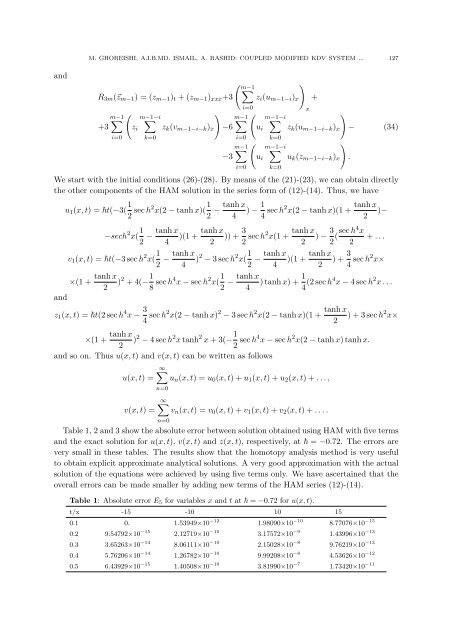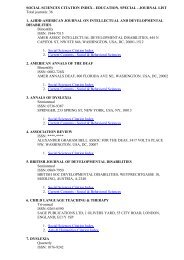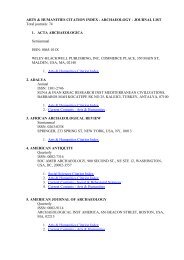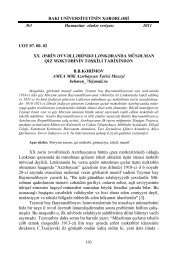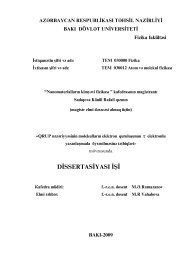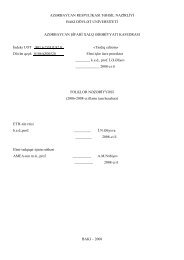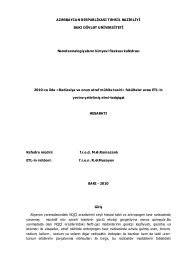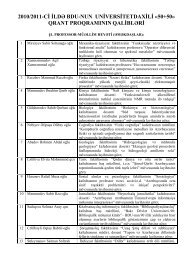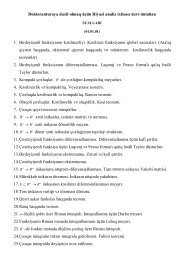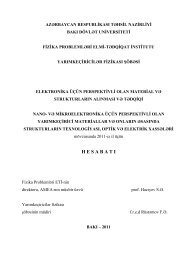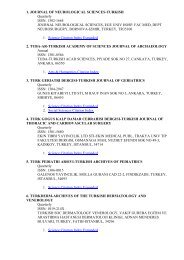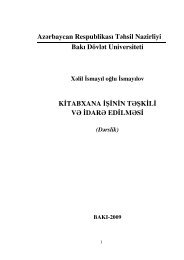THE SOLUTION OF COUPLED MODIFIED KDV SYSTEM BY THE ...
THE SOLUTION OF COUPLED MODIFIED KDV SYSTEM BY THE ...
THE SOLUTION OF COUPLED MODIFIED KDV SYSTEM BY THE ...
You also want an ePaper? Increase the reach of your titles
YUMPU automatically turns print PDFs into web optimized ePapers that Google loves.
and<br />
M. GHOREISHI, A.I.B.MD. ISMAIL, A. RASHID: <strong>COUPLED</strong> <strong>MODIFIED</strong> <strong>KDV</strong> <strong>SYSTEM</strong> ... 127<br />
R 3m (⃗z m−1 ) = (z m−1 ) t + (z m−1 ) xxx +3<br />
+3<br />
m−1<br />
∑<br />
i=0<br />
(<br />
∑<br />
z i<br />
m−1−i<br />
k=0<br />
z k (v m−1−i−k ) x<br />
)<br />
−6<br />
−3<br />
( m−1<br />
)<br />
∑<br />
z i (u m−1−i ) x<br />
i=0<br />
m−1<br />
∑<br />
i=0<br />
m−1<br />
∑<br />
i=0<br />
(<br />
(<br />
∑<br />
u i<br />
m−1−i<br />
k=0<br />
∑<br />
u i<br />
m−1−i<br />
k=0<br />
x<br />
+<br />
z k (u m−1−i−k ) x<br />
)<br />
−<br />
u k (z m−1−i−k ) x<br />
)<br />
We start with the initial conditions (26)-(28). By means of the (21)-(23), we can obtain directly<br />
the other components of the HAM solution in the series form of (12)-(14). Thus, we have<br />
and<br />
u 1 (x, t) = t(−3( 1 2 sec h2 x(2 − tanh x)( 1 2 − tanh x<br />
4<br />
−sech 2 x( 1 2 − tanh x<br />
4<br />
v 1 (x, t) = t(−3 sec h 2 x( 1 2 − tanh x<br />
4<br />
×(1 + tanh x<br />
2<br />
)(1 + tanh x<br />
2<br />
) − 1 4 sec h2 x(2 − tanh x)(1 + tanh x )−<br />
2<br />
)) + 3 2 sec h2 x(1 + tanh x ) − 3 2 2 (sec h4 x<br />
+ . . .<br />
2<br />
) 2 − 3 sec h 2 x( 1 2 − tanh x<br />
4<br />
)(1 + tanh x ) + 3 2 4 sec h2 x×<br />
) 2 + 4(− 1 8 sec h4 x − sec h 2 x( 1 2 − tanh x ) tanh x) + 1 4<br />
4 (2 sec h4 x − 4 sec h 2 x . . .<br />
z 1 (x, t) = t(2 sec h 4 x − 3 4 sec h2 x(2 − tanh x) 2 − 3 sec h 2 x(2 − tanh x)(1 + tanh x ) + 3 sec h 2 x×<br />
2<br />
×(1 + tanh x ) 2 − 4 sec h 2 x tanh 2 x + 3(− 1 2<br />
2 sec h4 x − sec h 2 x(2 − tanh x) tanh x.<br />
and so on. Thus u(x, t) and v(x, t) can be written as follows<br />
∞∑<br />
u(x, t) = u n (x, t) = u 0 (x, t) + u 1 (x, t) + u 2 (x, t) + . . . ,<br />
v(x, t) =<br />
n=0<br />
∞∑<br />
v n (x, t) = v 0 (x, t) + v 1 (x, t) + v 2 (x, t) + . . . .<br />
n=0<br />
Table 1, 2 and 3 show the absolute error between solution obtained using HAM with five terms<br />
and the exact solution for u(x, t), v(x, t) and z(x, t), respectively, at = −0.72. The errors are<br />
very small in these tables. The results show that the homotopy analysis method is very useful<br />
to obtain explicit approximate analytical solutions. A very good approximation with the actual<br />
solution of the equations were achieved by using five terms only. We have ascertained that the<br />
overall errors can be made smaller by adding new terms of the HAM series (12)-(14).<br />
Table 1: Absolute error E 5 for variables x and t at = −0.72 for u(x, t).<br />
t/x -15 -10 10 15<br />
0.1 0. 1.53949×10 −12 1.98090×10 −10 8.77076×10 −15<br />
0.2 9.54792×10 −15 2.12719×10 −10 3.17572×10 −9 1.43996×10 −13<br />
0.3 3.65263×10 −14 8.06111×10 −10 2.15028×10 −8 9.76219×10 −13<br />
0.4 5.76206×10 −14 1.26782×10 −10 9.99208×10 −8 4.53626×10 −12<br />
0.5 6.43929×10 −15 1.40508×10 −10 3.81990×10 −7 1.73420×10 −11<br />
.<br />
(34)


